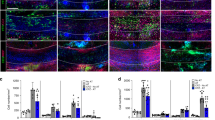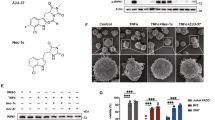Abstract
Survival and differentiation of oligodendrocytes are important for the myelination of central nervous system (CNS) axons during development and crucial for myelin repair in CNS demyelinating diseases such as multiple sclerosis. Here we show that death receptor 6 (DR6) is a negative regulator of oligodendrocyte maturation. DR6 is expressed strongly in immature oligodendrocytes and weakly in mature myelin basic protein (MBP)-positive oligodendrocytes. Overexpression of DR6 in oligodendrocytes leads to caspase 3 (casp3) activation and cell death. Attenuation of DR6 function leads to enhanced oligodendrocyte maturation, myelination and downregulation of casp3. Treatment with a DR6 antagonist antibody promotes remyelination in both lysolecithin-induced demyelination and experimental autoimmune encephalomyelitis (EAE) models. Consistent with the DR6 antagoinst antibody studies, DR6-null mice show enhanced remyelination in both demyelination models. These studies reveal a pivotal role for DR6 signaling in immature oligodendrocyte maturation and myelination that may provide new therapeutic avenues for the treatment of demyelination disorders such as multiple sclerosis.
This is a preview of subscription content, access via your institution
Access options
Subscribe to this journal
Receive 12 print issues and online access
$209.00 per year
only $17.42 per issue
Buy this article
- Purchase on Springer Link
- Instant access to full article PDF
Prices may be subject to local taxes which are calculated during checkout






Similar content being viewed by others
References
Miller, R.H. & Mi, S. Dissecting demyelination. Nat. Neurosci. 10, 1351–1354 (2007).
Miller, R.H. Regulation of oligodendrocyte development in the vertebrate CNS. Prog. Neurobiol. 67, 451–467 (2002).
Miller, R.H. et al. Patterning of spinal cord oligodendrocyte development by dorsally derived BMP4. J. Neurosci. Res. 76, 9–19 (2004).
Franklin, R.J. Why does remyelination fail in multiple sclerosis? Nat. Rev. Neurosci. 3, 705–714 (2002).
Franklin, R.J. Remyelination of the demyelinated CNS: the case for and against transplantation of central, peripheral and olfactory glia. Brain Res. Bull. 57, 827–832 (2002).
Franklin, R.J. & Hinks, G.L. Understanding CNS remyelination: clues from developmental and regeneration biology. J. Neurosci. Res. 58, 207–213 (1999).
Mi, S., Sandrock, A. & Miller, R.H. LINGO-1 and its role in CNS repair. Int. J. Biochem. Cell Biol. 40, 1971–1978 (2008).
Mi, S. et al. Promotion of central nervous system remyelination by induced differentiation of oligodendrocyte precursor cells. Ann. Neurol. 65, 304–315 (2009).
Mi, S. et al. LINGO-1 antagonist promotes spinal cord remyelination and axonal integrity in MOG-induced experimental autoimmune encephalomyelitis. Nat. Med. 13, 1228–1233 (2007).
Lee, X. et al. NGF regulates the expression of axonal LINGO-1 to inhibit oligodendrocyte differentiation and myelination. J. Neurosci. 27, 220–225 (2007).
Mi, S. et al. LINGO-1 negatively regulates myelination by oligodendrocytes. Nat. Neurosci. 8, 745–751 (2005).
Pang, Y., Cai, Z. & Rhodes, P.G. Effect of tumor necrosis factor-alpha on developing optic nerve oligodendrocytes in culture. J. Neurosci. Res. 80, 226–234 (2005).
Wang, S. et al. Notch receptor activation inhibits oligodendrocyte differentiation. Neuron 21, 63–75 (1998).
Mason, J.L. et al. Mature oligodendrocyte apoptosis precedes IGF-1 production and oligodendrocyte progenitor accumulation and differentiation during demyelination/remyelination. J. Neurosci. Res. 61, 251–262 (2000).
Guan, J. et al. Insulin-like growth factor-1 reduces postischemic white matter injury in fetal sheep. J. Cereb. Blood Flow Metab. 21, 493–502 (2001).
D'Ercole, A.J., Ye, P. & O'Kusky, J.R. Mutant mouse models of insulin-like growth factor actions in the central nervous system. Neuropeptides 36, 209–220 (2002).
Mason, J.L., Xuan, S., Dragatsis, I., Efstratiadis, A. & Goldman, J.E. Insulin-like growth factor (IGF) signaling through type 1 IGF receptor plays an important role in remyelination. J. Neurosci. 23, 7710–7718 (2003).
Chan, J.R. et al. NGF controls axonal receptivity to myelination by Schwann cells or oligodendrocytes. Neuron 43, 183–191 (2004).
Stidworthy, M.F. et al. Notch1 and Jagged1 are expressed after CNS demyelination, but are not a major rate-determining factor during remyelination. Brain 127, 1928–1941 (2004).
Ishibashi, T. et al. Astrocytes promote myelination in response to electrical impulses. Neuron 49, 823–832 (2006).
Brinkmann, B.G. et al. Neuregulin-1/ErbB signaling serves distinct functions in myelination of the peripheral and central nervous system. Neuron 59, 581–595 (2008).
Bossen, C. et al. Interactions of tumor necrosis factor (TNF) and TNF receptor family members in the mouse and human. J. Biol. Chem. 281, 13964–13971 (2006).
Pan, G. et al. Identification and functional characterization of DR6, a novel death domain-containing TNF receptor. FEBS Lett. 431, 351–356 (1998).
Schulze-Osthoff, K., Ferrari, D., Los, M., Wesselborg, S. & Peter, M.E. Apoptosis signaling by death receptors. Eur. J. Biochem. 254, 439–459 (1998).
Zhao, H. et al. Impaired c-Jun amino terminal kinase activity and T cell differentiation in death receptor 6-deficient mice. J. Exp. Med. 194, 1441–1448 (2001).
Nikolaev, A., McLaughlin, T., O'Leary, D.D. & Tessier-Lavigne, M. APP binds DR6 to trigger axon pruning and neuron death via distinct caspases. Nature 457, 981–989 (2009).
Clarke, P., Beckham, J.D., Leser, J.S., Hoyt, C.C. & Tyler, K.L. Fas-mediated apoptotic signaling in the mouse brain following reovirus infection. J. Virol. 83, 6161–6170 (2009).
Swarup, V., Ghosh, J., Das, S. & Basu, A. Tumor necrosis factor receptor-associated death domain mediated neuronal death contributes to the glial activation and subsequent neuroinflammation in Japanese encephalitis. Neurochem. Int. 52, 1310–1321 (2008).
Reich, A., Spering, C. & Schulz, J.B. Death receptor Fas (CD95) signaling in the central nervous system: tuning neuroplasticity? Trends Neurosci. 31, 478–486 (2008).
Mi, S. Troy/Taj and its role in CNS axon regeneration. Cytokine Growth Factor Rev. 19, 245–251 (2008).
Zhou, X.F. & Li, H.Y. Roles of glial p75NTR in axonal regeneration. J. Neurosci. Res. 85, 1601–1605 (2007).
Yamashita, T., Fujitani, M., Yamagishi, S., Hata, K. & Mimura, F. Multiple signals regulate axon regeneration through the Nogo receptor complex. Mol. Neurobiol. 32, 105–111 (2005).
Shao, Z. et al. TAJ/TROY, an orphan TNF receptor family member, binds Nogo-66 receptor 1 and regulates axonal regeneration. Neuron 45, 353–359 (2005).
Park, J.B. et al. A TNF receptor family member, TROY, is a coreceptor with Nogo receptor in mediating the inhibitory activity of myelin inhibitors. Neuron 45, 345–351 (2005).
Yamashita, T. & Tohyama, M. The p75 receptor acts as a displacement factor that releases Rho from Rho-GDI. Nat. Neurosci. 6, 461–467 (2003).
McGee, A.W. & Strittmatter, S.M. The Nogo-66 receptor: focusing myelin inhibition of axon regeneration. Trends Neurosci. 26, 193–198 (2003).
Wong, S.T. et al. A p75(NTR) and Nogo receptor complex mediates repulsive signaling by myelin-associated glycoprotein. Nat. Neurosci. 5, 1302–1308 (2002).
Mi, S. et al. Promotion of central nervous system remyelination by induced differentiation of oligodendrocyte precursor cells. Ann. Neurol. 65, 304–315 (2009).
Mi, S. et al. Syncytin is a captive retroviral envelope protein involved in human placental morphogenesis. Nature 403, 785–789 (2000).
Rubinson, D.A. et al. A lentivirus-based system to functionally silence genes in primary mammalian cells, stem cells and transgenic mice by RNA interference. Nat. Genet. 33, 401–406 (2003).
Mi, S. et al. Rodent EAE model for the study of axon integrity and remyelination. Nat. Protoc. doi:10.1038/nprot.2007.389 (2007).
Author information
Authors and Affiliations
Contributions
S.M. supervised all experiments and wrote the paper. X.L., Y.H., B.J., Z.S., W.Y., G.H., L.W. and B.J.G. performed experiments. K.R. and R.B.P. provided helpful discussions, and R.H.M. and R.B.P. revised the paper.
Corresponding author
Ethics declarations
Competing interests
The authors declare no competing financial interests.
Supplementary information
Supplementary Text and Figures
Supplementary Figures 1–6 (PDF 1159 kb)
Rights and permissions
About this article
Cite this article
Mi, S., Lee, X., Hu, Y. et al. Death receptor 6 negatively regulates oligodendrocyte survival, maturation and myelination. Nat Med 17, 816–821 (2011). https://doi.org/10.1038/nm.2373
Received:
Accepted:
Published:
Issue Date:
DOI: https://doi.org/10.1038/nm.2373
This article is cited by
-
Discovery and replication of blood-based proteomic signature of PTSD in 9/11 responders
Translational Psychiatry (2023)
-
Neuroglial components of brain lesions may provide new therapeutic strategies for multiple sclerosis
Neurological Sciences (2023)
-
Alterations in microRNA of extracellular vesicles associated with major depression, attention-deficit/hyperactivity and anxiety disorders in adolescents
Translational Psychiatry (2023)
-
Genome-wide interaction study with major depression identifies novel variants associated with cognitive function
Molecular Psychiatry (2022)
-
Cerebrospinal fluid proteomics targeted for central nervous system processes in bipolar disorder
Molecular Psychiatry (2021)



